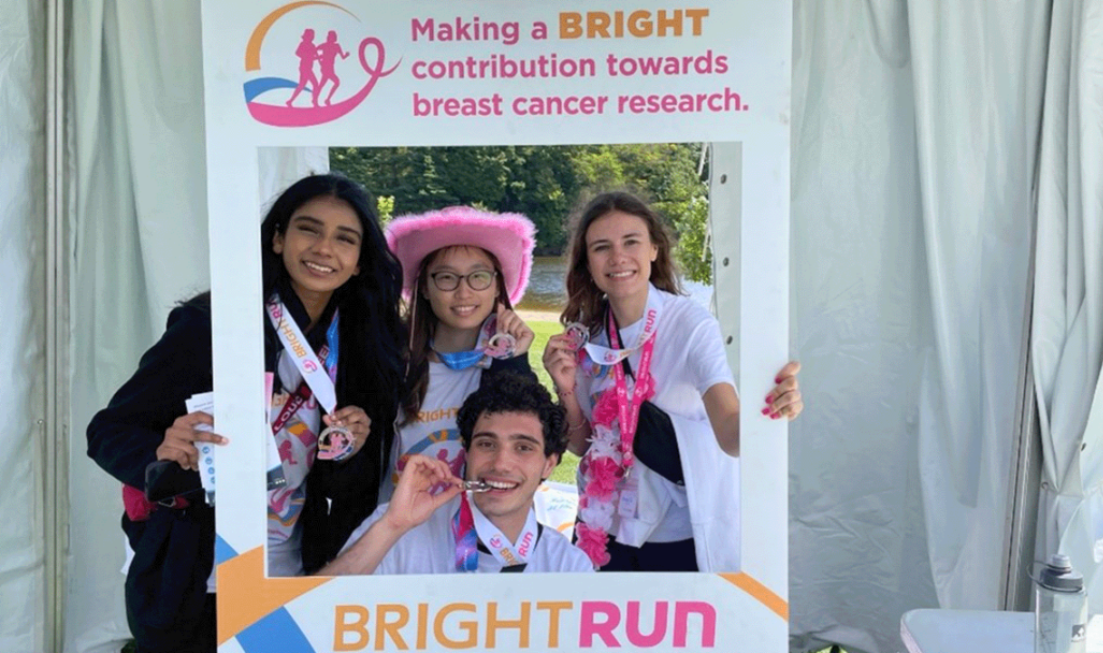Students team up across faculties for innovative breast cancer treatment project

An interdisciplinary, student-led synthetic biology team is making major strides in breast cancer research – in the lab and in the community. (McMaster iGEM photo)
BY Adam Ward, Faculty of Health Sciences
October 9, 2024
An interdisciplinary team of McMaster students is making major strides in breast cancer research – in the lab and out in the Hamilton community.
The International Genetically Engineered Machine (iGEM) team, comprising students from a variety of disciplines across the university, identifies a goal and works to solve it using synthetic biology, which is like engineering for living things.
Now they’re creating a bacteria-powered delivery system for cancer therapeutics, and raising money and support for research in the Hamilton area.
Aiding them are principal investigators Jonathan Bramson, the vice-dean of research for the Faculty of Health Sciences, and Tohid Didar, an associate professor of mechanical engineering in the Faculty of Engineering.
The team hopes their ambitious project, called Hermes, will change how we perceive bacteria and how patients receive cancer treatment.
“The goal is to make drug delivery more efficient while taking away the negative side-effects, particularly the off-target toxicity that usually comes with traditional cancer therapies,” says Chantal Luo, a fourth-year student in the Chemical and Biomedical Engineering program, and the outgoing co-president of McMaster’s iGEM team.
Traditional chemotherapy targets cancer using drugs that travel through the bloodstream. Any excess drugs continue to circulate in the body, causing side effects, until they make their way out.
The iGEM team is administering bacteria that is specifically engineered to latch on to a sugar found on solid tumour cells, Luo explains.
“Once it latches on, it releases the drug. This reduces the amount of treatment casually floating around in the bloodstream.”
Because the bacteria is alive, it will continue to grow until the tumour is gone, so patients won’t need as big a dose to start, says Andrew Chami, outgoing co-president alongside Luo, and a fourth-year student in the Honours Health Sciences Program.
“Currently, if you provide a single administration of a drug dose, you’re going to get that one-time punch,” Chami says.
“But if you have something that’s constantly producing this drug, it will be more efficient and effective.”
Aiming for gold in Paris
This month, the McMaster iGEM team — and Hermes — will compete against iGEM teams from around the world at the International Genetically Engineered Machine Grand Jamboree in Paris.
Each team uses synthetic biology to tackle a problem of their choosing. While only one team can capture the top prize — the coveted BioBrick Trophy — the event also offers a unique opportunity to meet others in the field, explains Mya George, a first-year student in the Master of Arts in Health & Aging program.
“You get to network and connect with other teams from around the world,” George says. “There’s also a lot of industry members there as well.”
Last year, the McMaster team took home silver for their project: an ingestible biosensor to study gut metabolites associated with major depression.
Win or lose, the project gives students invaluable experience.
““It has been a pleasure and truly exciting to collaborate with this dynamic and hardworking iGEM team,” Didar says. “I am confident that the experience they have gained through their involvement in iGEM will significantly benefit them in their future endeavours.”
Fighting cancer outside the lab
Over the summer, Chami, George and Luo took part in Bright Run, an annual event to raise money for local breast cancer research projects.
Not only did they raise money, they also walked and ran alongside many people who have been touched by cancer.
“It’s one thing to read about the symptoms and challenges people go through when they’re undergoing cancer therapy,” George says. “It’s another thing to be there running alongside people who have gone through that, listening to their stories and how it’s impacted them and their families.”
That experience “made it it very clear that we’re not treating the monster that is breast cancer, but the patient who has breast cancer,” Chami says.
“That’s why when we are creating delivery mechanisms: We want to make sure we’re designing them with empathy and we’re designing with the patient in mind.”
The iGEM team is also developing a comic book focused on CAR-T cells – a type of immunotherapy used to treat certain cancers – to help people better understand the treatment.
The team’s creativity and ambition is inspiring, Bramson says.
“It is a pleasure to mentor these young people as they pursue their dream of developing novel therapies through synthetic biology,” he says.
“These are exactly the types of young researchers that our university aims to foster.”


